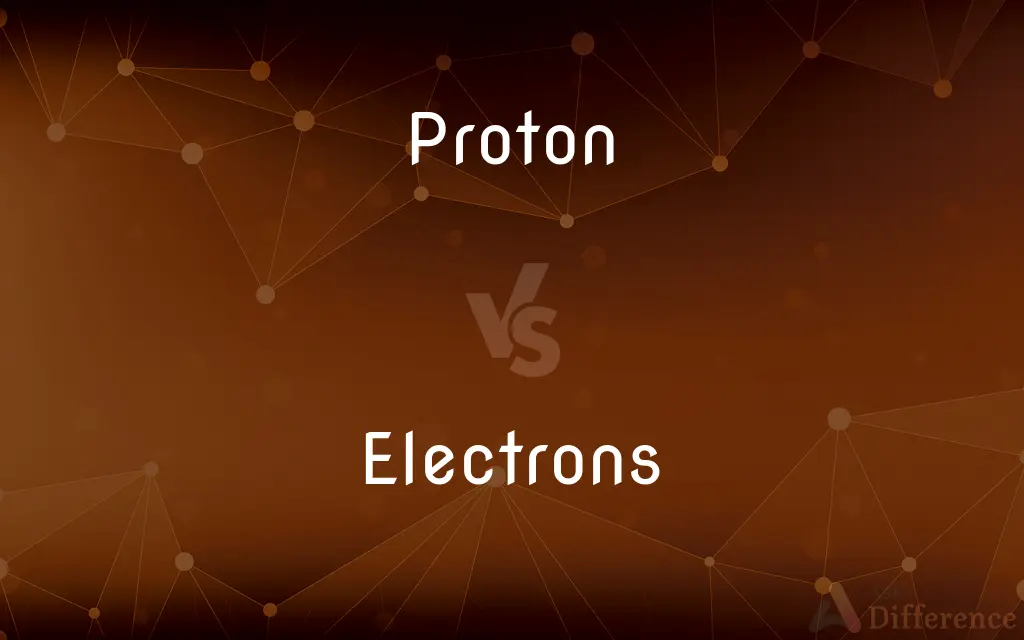Proton vs. Electrons — What's the Difference?
Edited by Tayyaba Rehman — By Fiza Rafique — Published on December 19, 2023
Protons are positively charged particles in an atom's nucleus, while electrons are negatively charged particles orbiting the nucleus.

Difference Between Proton and Electrons
Table of Contents
ADVERTISEMENT
Key Differences
Protons are fundamental particles found within an atom's nucleus. Their presence contributes to the atomic number of an element, determining its identity on the periodic table. On the other hand, electrons are found outside the nucleus in regions called orbitals or shells. Their arrangement dictates an atom's chemical properties and behavior.
A significant distinction between protons and electrons lies in their charges. Protons carry a positive charge, while electrons have a negative charge. This difference is crucial because it ensures that atoms, under normal circumstances, remain electrically neutral when the number of protons equals the number of electrons.
The mass of a proton is considerably larger than that of an electron. While the proton is one of the primary constituents of an atom's mass (along with neutrons), electrons are so light that their contribution to an atom's total mass is negligible.
Both protons and electrons play vital roles in various physical phenomena. Protons, being in the nucleus, largely determine an atom's identity. In contrast, electrons, with their negative charge and peripheral location, govern atomic bonds, conductivity, and various other chemical and physical properties.
Comparison Chart
Location
In the atom's nucleus.
Orbiting outside the nucleus in shells or orbitals.
ADVERTISEMENT
Charge
Positive.
Negative.
Contribution to Mass
Significant (similar to neutrons).
Negligible.
Role in Atom
Determines atomic number and element identity.
Influences chemical properties and bonding.
Relative Mass
Much heavier than electrons.
Much lighter than protons.
Compare with Definitions
Proton
One of the determinants of an atom's identity.
Changing the number of protons in an atom changes the element itself.
Electrons
Essential for electrical conductivity.
Metals conduct electricity due to the movement of free electrons.
Proton
A positively charged particle in an atom's nucleus.
Hydrogen's nucleus contains just one proton.
Electrons
Particles responsible for chemical bonding.
The sharing or transfer of electrons leads to chemical bonds.
Proton
Essential for maintaining the electrical neutrality of atoms.
In a neutral atom, the number of protons equals the number of electrons.
Electrons
Negatively charged particles that orbit an atom's nucleus.
Electrons move around the nucleus in specific shells.
Proton
The primary contributor to an element's atomic number.
Carbon, with six protons, has an atomic number of six.
Electrons
Light particles with negligible contribution to atomic mass.
The mass of electrons is often ignored in atomic mass calculations.
Proton
A heavy constituent of the atomic nucleus.
Protons and neutrons account for nearly all of an atom's mass.
Electrons
Dictate an atom's chemical and physical properties.
Different arrangements of electrons give elements distinct characteristics.
Proton
The stable, positively charged nucleon, having a mass 1,836 times that of an electron and being a baryon composed of two up quarks and one down quark. The proton is a basic component of all atomic nuclei and the nucleus of the protium isotope of hydrogen.
Electrons
A stable elementary particle in the lepton class having a negative electric charge of 1 elementary unit (about 1.602 × 10-19 coulombs) and a mass of about 9.11 × 10-28 grams. Electrons are found in shells orbiting the nuclei of atoms and can also move freely through space as cathode rays in a cathode-ray tube or as beta particles emitted by radioactive nuclei, or flow in a current through a conducting material impelled by an electric potential difference.
Proton
(particle) A positively charged subatomic particle forming part of the nucleus of an atom and determining the atomic number of an element, composed of two up quarks and a down quark.
Electrons
Plural of electron
Proton
The atomic nucleus of protium hydrogen-1}}
Proton
Synonym of primordium
Proton
A stable particle with positive charge equal to the negative charge of an electron
Common Curiosities
Where are protons located in an atom?
Protons are located in the atom's nucleus.
How does changing the number of protons affect an atom?
Changing the number of protons changes the element itself.
Are electrons heavier than protons?
No, electrons are much lighter than protons.
How do electrons influence electricity?
Electrons, being mobile and negatively charged, are responsible for electrical conductivity.
How do electrons contribute to chemical bonding?
Electrons are involved in the sharing or transfer that forms chemical bonds.
Do protons and electrons have the same charge but different signs?
Yes, protons have a positive charge while electrons have a negative charge.
What is the charge of a proton?
A proton carries a positive charge.
What determines the chemical behavior of an atom?
The arrangement and number of electrons largely determine an atom's chemical behavior.
What happens if an atom has more electrons than protons?
It becomes a negatively charged ion, called an anion.
Why are protons crucial to an element's identity?
Because the number of protons determines the atomic number and thus the element's identity.
What role do protons play in the atomic mass?
Protons, along with neutrons, contribute significantly to an atom's mass.
Which particle, proton or electron, plays a primary role in chemical reactions?
Electrons play a primary role in chemical reactions due to their involvement in bonding.
Are the masses of protons and electrons similar?
No, protons are much heavier than electrons.
Do electrons reside inside the nucleus?
No, electrons orbit outside the nucleus in shells or orbitals.
How do electrons and protons interact in a neutral atom?
In a neutral atom, the number of electrons equals the number of protons, balancing the charges.
Share Your Discovery

Previous Comparison
Idioms vs. Proverbs
Next Comparison
Pressure Group vs. Interest GroupAuthor Spotlight
Written by
Fiza RafiqueFiza Rafique is a skilled content writer at AskDifference.com, where she meticulously refines and enhances written pieces. Drawing from her vast editorial expertise, Fiza ensures clarity, accuracy, and precision in every article. Passionate about language, she continually seeks to elevate the quality of content for readers worldwide.
Edited by
Tayyaba RehmanTayyaba Rehman is a distinguished writer, currently serving as a primary contributor to askdifference.com. As a researcher in semantics and etymology, Tayyaba's passion for the complexity of languages and their distinctions has found a perfect home on the platform. Tayyaba delves into the intricacies of language, distinguishing between commonly confused words and phrases, thereby providing clarity for readers worldwide.
















































